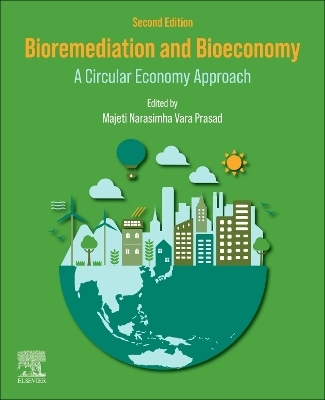
Bioremediation and Bioeconomy
Elsevier - Health Sciences Division (Verlag)
978-0-443-16120-9 (ISBN)
Majeti Narasimha Vara Prasad is Emeritus Professor in the School of Life Sciences at the University of Hyderabad in India. He received his PhD in Botany from Lucknow University, Lucknow. In past he worked as Lecturer at North Eastern Hill University, Lecturer & Reader at University of Hyderabad. He is also serving as reviewer in many scientific journals. He is professional member of National Institute of Ecology New Delhi, India, Bioenergy Society of India, New Delhi, Indian Network for Soil Contamination Research, New Delhi. He also completed 20 research projects. He has published 179 articles in peer review journals in which contributed as author/co-author. He supervised 17 PhD and 7 M.Phil students, all students received award in his supervision.
Preface Section I. Bioproducts from contaminated soil and water 1. Integrating the Bioremediation, Bioeconomy, circular economy as strategic sustainability 2. Biorefinery, bioeconomy and circular economy accelerate carbon neutrality - Insights from life cycle assessment. 3. Trace element contaminated agrocenoses in Ukraine for production of biodiesel 4. Aromatic, medicinal and energy plantations on metalliferous/contaminated soil - bioremediation and bioeconomy 5. Prosopis juliflora (Sw) DC - potential for bioremediation and biobased economy 6. Giant reed (Arundo donax L.): a multipurpose crop bridging phytoremediation with sustainable bio- economy Section II. Biomass Energy and Biofuel from contaminated substrates 7. Energy recovery from phytoremediated phytomass of aquatic plants via gasification 8. Jatropha curcas L. cultivation on constrained land - Exploring the potential for economic growth and environmental protection Section III. Ornamentals and Tree crops for contaminated substrates 9. POTENTIAL OF ORNAMENTAL PLANTS FOR PHYTOREMEDIATION AND INCOME GENERATION 10. Native Trees on Abandoned Mine Land: From Environmental Remediation to Bioeconomy 11. Rice plants for cleanup of trace elements - Bioeconomic perspectives 12. Duckweed – Bioremediation and biorefinery 13. Cultivation of sweet sorghum on heavy metal contaminated soils by phytoremediation approach for production of sweet fuel 14. Production of Biodiesel/ Biocomposites from sunflower cultivated on contaminated soil Section IV. Brownfield development for smart bioeconomy 15. Chrysopogon zizanoides (Vetiver grass) for phytoremediation and restoration: co-generation of economical products 16. Mulberry (Morus) for phytostabilizaion of coal mine over burden: co-generation of economic products 17. Utilization of contaminated lands for cultivation plant resources for production of dyes 18. Bioeconomy and Circular Economy Approaches for the Greening of Urban Wastelands - Focus on Biodiversity to Achieve Sustainability 19. Biological Recultivation of Fly Ash Dumps Strengthening Bioeconomy and Circular Economy in the Ural Region of Russia Section V. Algal bioproducts, biofuels, biorefinery for business opportunities 20. Phycoremediation and business prospects 21. Algae based bioremediation: Bioproducts and biofuels for biobusiness Section VI. Bioprocesses, Bioengineering for boosting biobased economy 22. Building circular bio-based economy through sustainable waste management Section VII. Case studies 23. Bioremediation in Brazil: recent evolutions and remaining challenges to boost up the bioeconomy 24. Phytomanagement of polycyclic aromatic hydrocarbons and heavy metals contaminated sites in assam, north eastern state of india for boosting bio-economy Section VIII. New Biology 25. From preservation of aquatic ecosystems to ecocatalysis 26. Synthetic Biology: An Emerging Field for Developing Economies
| Erscheinungsdatum | 17.11.2023 |
|---|---|
| Verlagsort | Philadelphia |
| Sprache | englisch |
| Maße | 191 x 235 mm |
| Gewicht | 1620 g |
| Themenwelt | Naturwissenschaften ► Biologie ► Ökologie / Naturschutz |
| ISBN-10 | 0-443-16120-8 / 0443161208 |
| ISBN-13 | 978-0-443-16120-9 / 9780443161209 |
| Zustand | Neuware |
| Haben Sie eine Frage zum Produkt? |
aus dem Bereich


